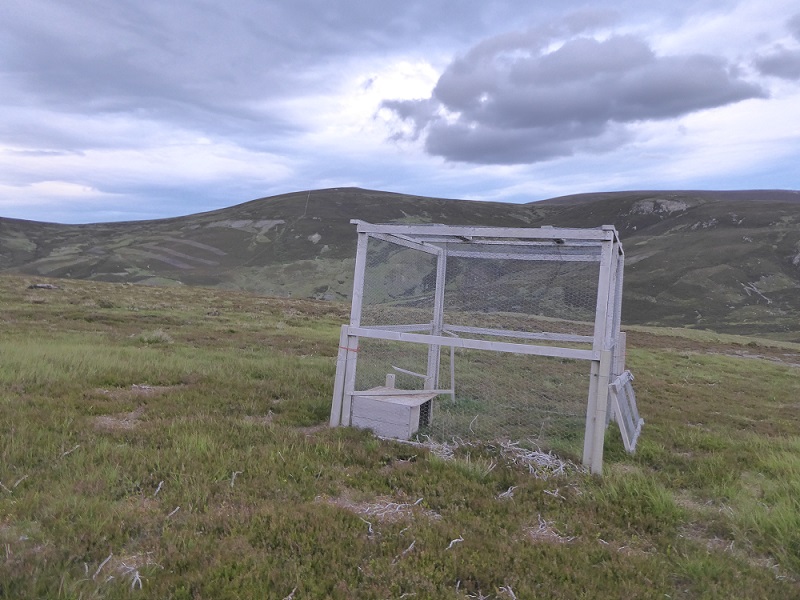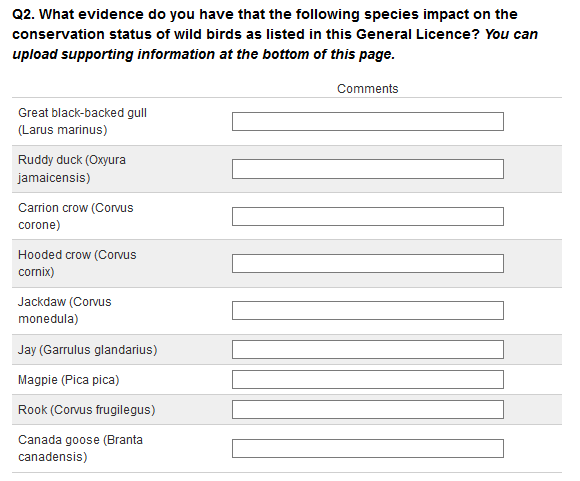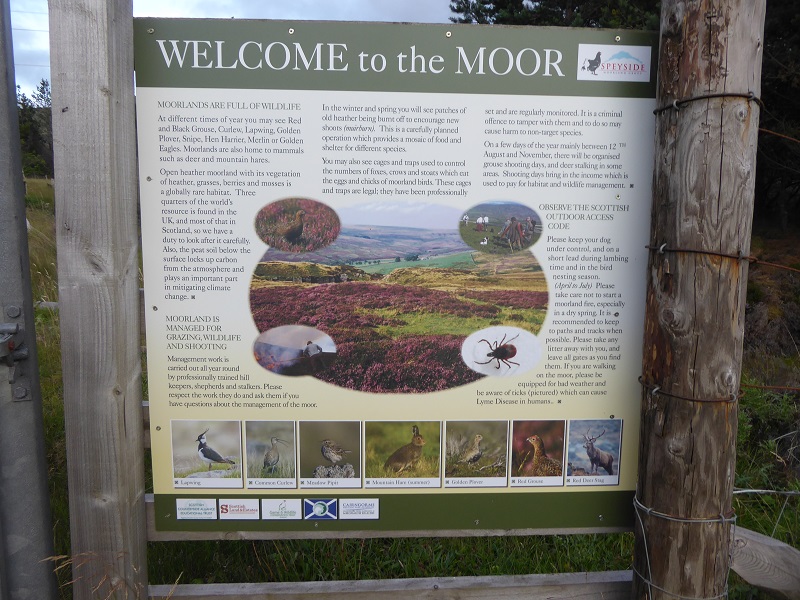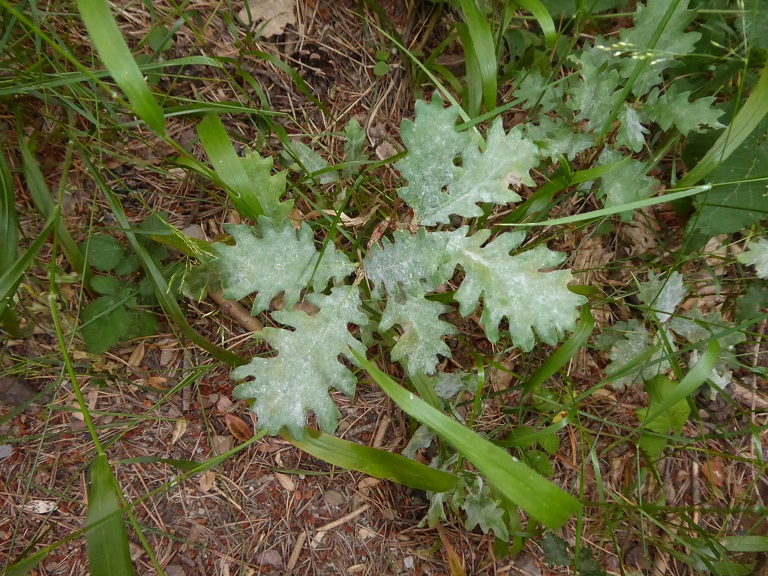
Its now over 6 weeks since Scottish Natural Heritage opened its consultation on the General License (see here) which runs until Weds 9th October. This post takes a look at the consultation, how the licensing system for killing wild birds in Scotland operates and argues that different and higher standards should apply in our National Parks and other protected areas.
Evidence and the General License consultation
SNH’s consultation appears to have been prompted by the successful legal challenge by Wild Justice (see here) to the way the General License has been operated in England. It has all the appearances of a rushed job which has been unduly influenced by landowning interests.
There are, amazingly, no background documents to accompany the consultation (see here for survey and to respond), simply a link to SNH’s web page on the General License. There is no information of how the licenses are working in Scotland, no attempt to analyse how this relate to bird populations and no consideration given to the role that bird species, which are currently culled under the General License, could or should have in ecosystems, including protected areas such as National Parks. In effect SNH is asking for feedback on how the General License is working without providing any of the information it and other bodies hold which is relevant to this and might facilitate constructive feedback.
This failure to base the consultation on evidence or analysis has not prevented SNH from smuggling into the consultation , as revealed by Raptor Persecution Scotland (see here), a proposal to add the raven to the list of bird species which can be legally killed under the General License. The one piece of conservation evidence SNH provides in the consultation to support this is a summary of the conservation status of birds that are covered by the General License or which SNH is thinking of adding to It:

The logic appears to be that Ravens are not threatened nationally, so there is no reason not to add them to the list of birds that can be killed. The converse, however, has not been applied: there are no proposals from SNH to remove the Greater and Lesser Black Backed Gulls or the Herring Gull from the list.
Having failed to present and critically evaluate the evidence it holds, SNH is asking respondents for what evidence they have about the impacts of certain wild bird species. For example:
 The outcome of the way the survey has been framed is predictable. Landowners and land managers, including gamekeepers, are likely to see this as an opportunity to deluge SNH with the allegations they regularly make about certain species causing damage. The 1000s of ordinary citizens who are concerned about the slaughter of wildlife in our countryside, if they ever look at the survey, are likely to ask themselves, what evidence do I have?
The outcome of the way the survey has been framed is predictable. Landowners and land managers, including gamekeepers, are likely to see this as an opportunity to deluge SNH with the allegations they regularly make about certain species causing damage. The 1000s of ordinary citizens who are concerned about the slaughter of wildlife in our countryside, if they ever look at the survey, are likely to ask themselves, what evidence do I have?
For example, a number of birds nest in the small urban gardens on the street I live in Glasgow and there are also resident magpies. Despite regularly looking out my back window when working at the computer I have never seen magpies predate on any of the other garden birds (though I have seen sparrowhawk do so). Does that count as evidence and, if so, evidence of what? In the example of birds in my street, the RSPB annual garden bird survey would provide a much better basis for an analysis of the relationship between magpie and other bird populations.
Britain has the best bird recording system in the world, thanks to organisations like the British Trust for Ornithology, so why hasn’t SNH explained what should count as evidence and how the new evidence its calling for will be analysed in the light of what is held already? People killing birds under the General License at present have to report very little to SNH. For example, under General License 1 (see below) the main reporting requirement is that when Larsen traps use meat bait, landowners must provide SNH with information about the number of “non-target birds” which are caught. Had SNH asked land owners and managers to submit information about the numbers of birds that are being killed under the General Licenses that might added to what is known already and added to the debate. It will be interesting to see if there are any landowners who will be prepared to make information on the number of birds that they are killing under the General License public.
Perhaps the seven estates in the East Cairngorms Moorland Partnership, the Cairngorms National Park Authority’s chosen mechanism for improving grouse moor management, will make any information they hold available and set an example for the rest of the country?
The consultation and the law on wild birds in Scotland
The Wildlife and Countryside Act 1981, which applied to both England and Scotland and forms the basis for our current law, made it illegal to kill “wild birds” or destroy their nests. However, it exempted game birds or other “quarry “species from this protection. This has allowed hunting of species ranging from those that are effectively farmed, such as pheasants and red legged partridge, to those that are wild, such as snipe and ptarmigan, to continue. The Act also contained two types of provision to allow wild birds to be killed or otherwise controlled in certain circumstances, general licenses and specific licenses.
There are currently 14 different general licenses which operate in Scotland (see here). These cover a range of species and circumstances. including captive bred birds and airport safety. A number of years ago Scottish Natural Heritage took over responsibility for issuing these licenses from the Scottish Government. The current consultation is on the first three of these general licenses (the same licenses that were subject to the successful legal challenge by Wild Justice).
Interestingly, there is no consultation on General License 5 which allows Red Grouse to be captured in nets for the purpose of administering medication for disease control. That would appear very relevant to the future of intensive grouse moor management, which is currently subject to so much public debate and is being considered by the Werrity Review, so why did SNH not grab the opportunity and consult on that too?
The three General licenses being consulted on allow the killing or control of the certain species in the following circumstances:
- “For the purposes of conserving other bird species” (General License 1). The species included are Magpie, Carrion crow, Hooded crow, Jackdaw, Jay, Rook, Ruddy duck, Canada goose and
Great black-backed gull. (In most cases, these birds are included because they predate on the eggs and young of other birds but in the case of the Ruddy Duck, its because it interbreeds with white headed duck, producing fertile hybrids which threaten the viability of white headed duck as a separate species). - “For the purpose of preventing serious damage to livestock, foodstuffs for livestock, crops, vegetables and fruit” (General License 2). The species currently included are Collared dove, Feral pigeon, Wood pigeon, Carrion crow ,Hooded crow, Jackdaw, Magpie, Rook, Canada goose, Resident Greylag goose and Great black-backed gull.
- “For the purpose of preserving public health, public safety and preventing the spread of disease” (General License 3). The species currently included are Great black-backed gull, Lesser black-backed gull, Herring gull, Collared dove, Feral pigeon, Wood pigeon, Carrion crow, Hooded crow, Jackdaw, Magpie, Rook and Canada goose.
Besides the species covered under the General Licensing framework, land managers and others can also apply to kill or control other species in specific circumstances. The Ferret, in an excellent investigative piece a couple of months ago, revealed the extent of these licenses and the killing (of birds and other animals) it had obtained through a Freedom of Information Request (see here):
“Since 2014 SNH has issued almost 4,000 licences to farmers, landowners and others to kill 97,500 geese, 11,400 hares, 10,000 gannets and 6,000 ravens. Hundreds of goosanders, cormorants, jackdaws, starlings, gulls, magpies and pigeons were also allowed to be killed.
The licences covered a total 63 animal species, 51 of which were birds including many familiar species such as sparrows, robins, tits, blackbirds, thrushes, skylarks, swallows, swifts, swans and herons. Other animals on the hit list were beavers, shrews, moths, fish, lizards and toads”.
The detailed data showed that in the last five years SNH has issued 941 licences to kill 6,053 ravens, which are blamed for attacking and killing lambs. The consultation makes no reference to this data although it appears to explain why SNH decided to include in their consultation a proposal to add ravens to the General License. What the data tells us is that SNH is issuing so many licenses to kill ravens at present that in effect this species is no longer protected. Adding ravens to the General License would also save SNH a lot of work.
The system for issuing specific licenses
SNH claim to apply a rigorous licensing system:
“SNH, in keeping with the principles of Better Regulation and our responsibilities under the Scottish Regulators’ Strategic Code of Practice, aim to ensure that the way in which we deliver our species licensing service is efficient, effective, proportionate and adaptable”.
This claim appears unlikely To issue almost 4000 special licenses over 5 years implies they are granting about 800 specific licenses a year, or 3-4 every working day. SNH has suffered higher staff cuts than most other public authorities since 2008 and it is difficult to see how this is anything more than a paper exercise. What conceivable need, for example, is there to grant licenses to people to kill robins (as revealed by the Ferret)?
As another example, the framework for the operation of the special license for ravens in theory could be argued to be quite rigorous. There are detailed guidelines for farmers applying for a license on the grounds that ravens are attacking livestock (see here) and an application form which requires them to say where and when such attacks have occurred (see here). The wording in the form, however, suggests that if farmers fill in the right boxes, the granting of the license is a foregone conclusion:
Provide details on the location of where the damage is occurring, number of raven causing damage, where shooting will be carried out and period of shooting
Note, its not “where do you PROPOSE to carry out the shooting and when” but rather “where WILL the shooting be carried out”.
There are other hints of a corrupt process. The Guidance suggests one way for farmers to avoid ravens attacking livestock is to keep that livestock indoors at certain time but the form, in asking land managers where damage is occurring, provides calving sheds as an example! Perhaps SNH should tell us how many attacks by ravens on livestock have been reported to take place in calving sheds?
While the Guidance suggests that farmers should provide photographic evidence of damage and also provide evidence that the damage was done by ravens and not other species, the SNH form doesn’t require the submission of any such evidence. This suggests SNH’s operational process may be undermining both the guidance and the law.
Whether anyone at SNH is taking a critical look at how the system for specific licenses operates, however, is another matter. There is no mention of specific licenses in the consultation on the General License despite the two being obviously interconnected.
So how is the General License Working? Conservation and our National Parks.
There are some very serious issues with the way the General License is operating, which is why Wild Justice brought their case in England. SNH’s consultation says NOTHING to enlighten people in Scotland about what these issues in England are or consider how they might be applicable to how the system operates in Scotland.
For example, Mark Avery, ex-RSPB turned radical campaigner who helped found Wild Justice, explains very clearly on his blog how the General License for wood pigeons, which allows them to be killed to prevent serious damage to crops, is widely thought to allow recreational shooting (see here). It doesn’t, which means even shooting of wood pigeon for food is at present unlawful, although as Mark says that leaves the question of whether such shooting should be legalised. The point is the law is a mess and not fit for the purpose.
This includes our National Parks which have a statutory duty to protect wildlife. Here are two examples which relate to corvids (ravens, crows, jays, jackdaws and magpies) which are widely killed within our National Parks.
Corvids and Grouse moors
The grouse moors in the Cairngorms National Park are littered with crow traps (top photo). We don’t know how many corvids are killed through trapping and how many through shooting because there is NO requirement for land managers to report this.
The legal basis for such trapping on grouse moors, however, is highly questionable. The killing that takes place on grouse moors is almost certainly not justified under General License 2 (protection of crops and livestock) or General License 3 (Public Health and Safety). Its justification therefore can only be under the terms of General License 1, “for the purposes of conserving other bird species”.
The primary reason why there there are traps on grouse moors is because corvids predate on red grouse and grouse moor management is all about increasing numbers of red grouse (muirburn, killing predators, reducing any animal which could carry diseases which infect red grouse, use of medicated grit etc). The main legal justification for these traps therefore depends on the need for “conserving red grouse”. Conserving a bird species for the fundamental purpose of then shooting it seems both contradictory in itself and somewhat contrary to the wording and spirit of the Wildlife and Countryside Act. Indeed, Red Grouse are not in any case primarily classified as a wild bird under the Act, but rather as a “Game Bird” which is covered by the Game Acts and are certainly not at risk. It therefore appears questionable legally whether these traps, whose main purpose is to increase red grouse numbers, are legal under the terms of the General License.
Landed estates of course could accept this argument but then try and argue that these traps are not there for “conserving” grouse but rather for conserving other wild birds. Seen in this context, the Welcome to the Moor/Don’t tray off the path” signs are not just about controlling walkers so they don’t see what’s really going on, but are also about giving credence to the idea that grouse moors are trying to conserve certain species (notably waders).

What, however, is the evidence for wader numbers being higher in areas where corvids are controlled than where they are not? In that respect SNH’s decision to suspend the trial cull of ravens in Strathbraan in May because their own scientific committee (see here) concluded they had no way of assessing the impact of the raven cull on wader numbers is significant:
Executive Summary
Committee members supported the concept that further work on quantifying the impact of predators on wader populations is desirable, with a view to possible mitigation management. However, committee members were unanimous in the view that the existing trial methods, both as originally outlined in the licence application and as practiced in 2017, are completely inadequate and will fail to provide any meaningful scientific evidence for or against any effect of culling ravens on wader populations. Some advice is therefore offered on further work in this area of adaptive management.
If SNH doesn’t know the impact of a very specific cull of a corvid on wader numbers, how can landowners possibly know whether their own culls are conserving wild birds or not? Without evidence that these traps are actually helping conserve wader numbers, any legal justification for killing them under General License falls. This argument is all the stronger in our National Parks where there is a statutory duty to protect wildlife.
Jays, wildlife and woodland regeneration
At present Jays, a woodland bird, are included under General License 1, i.e they can be killed for the purposes of for conserving other birds only. The evidence to support this was questioned earlier this summer by the British Trust for Ornithology (see here). Instead of reviewing the evidence for Scotland, SNH has left the Jay on the list of species it believes should continue to be culled.
As the Scottish Government’s statutory conservation agency, however, SNH should be taking a far wider look at the role of birds in ecosystems. I started to think about the jay this summer in the Pyrenees. Why was i, that almost everywhere we walked in montane woodland could we hear the screech of jays, when in the oakwoods in the Loch Lomond and Trossachs National Park such sounds are rare? I then heard the likely explanation, information from the Game and Wildlife Conservation Trust suggests something like 12,000 Jays a year are killed under the General License (see here) .
I then started thinking about how this related to the natural wood regeneration we saw all over the Pyrenees (see here) and more specifically about how this oak sapling sprang up in a place where there was not an oak tree in sight:

The most likely explanation I can think of is the jay, which bury acorns for future use, some of which then get missed and develop into oak trees.
Both our National Parks claim to want to expand areas of native woodland – and indeed this in now a priority under the climate emergency. The cheapest and probably the most effective way of doing this is to allow nature to do the work. That means reducing deer and sheep numbers but also should mean a ban on killing any of the animals which assist this process. Protection for the jay should be one of the starting points for re-wilding, instead we allow jays to be slaughtered.
Unfortunately there is no consideration of the wider conservation picture in SNH’s consultation on the General License. Both our National Parks, which also have a statutory duty to put conservation first, should be calling on SNH to give special consideration to the operation of the General License in their areas. Calling for the jay to be removed from the General License would be a good start.
What needs to happen
In my view, as well as a proper review of the operation of the General Licenses, serious consideration should now be given to removing protected areas from General Licenses 1,2,3 and 5 (trapping of red grouse). This should include National Parks, Special Area of Conservation, Special Protection Areas and Sites of Scientific Interest (except maybe those designated for geological features). This wouldn’t mean that all those birds listed under the General License at present could never be lawfully killed in these areas. Land managers could always apply for a specific license to do so (as happens with ravens). The presumption, however, would be that ALL wildlife should be protected in our National Parks and other protected areas unless there was very specific evidence to justify that wildlife being killed.
Such a change in the law and our approach to wildlife would be popular. Most people expect that our National Parks should be protected areas for wildlife and that the standards that are applied there should be higher than in other areas.
It wouldn’t, however, address all the conceptual contradictions which lie at the heart of how we manage wildlife at present and which impact on what our National Parks can achieve. I will consider these in a further post.

DISPERSAL OF ACORNS BY THE EURASIAN JAY © RSFS SCOTTISH FORESTRY VOL 68 NO I 20I4
Long-distance colonisation of oak dispersed by jays in Highland Scotland
Richard Worrell, Cristina Rosique and Richard Ennos. RSFS SCOTTISH FORESTRY VOL 68 NO 1 2014
are two fascinating papers highlighting the importance of jays in the regeneration of oak woods.
There is no justification at all for having jay on the general licence.
Thank you for the reference, fantastic, thank you, Nick
Regarding “The licences covered a total 63 animal species, 51 of which were birds including many familiar species such as sparrows, robins, tits, blackbirds, thrushes, skylarks, swallows, swifts, swans and herons”
Is it always the case that a license is a license to kill? I had thought that some of these licenses were permitted to allow actions that aided birds’ survival chances.
I’ve seen jackdaws in the early morning taking nestlings. Just nature. But the large number of jackdaws in Kingussie-Newtonmore is at least partially due to a careless attitude to food waste. That’s not to argue for their killing but I do think that some bird populations are not in balance. I’ve been attacked walking from the house by a black headed gull. Again numbers of scavenging gulls here are large because of man’s carelessness. Do we have some right to” correct” a species imbalance that we have created?
In the same way is it right for example to be feeding alien niger seeds to goldfinches?
Happily, in Badenoch, I’ve seen or heard more jays this year than in any previous year.
Dick, good question about whether special licenses are always issued to kill. If you click on the link to the Ferret article on the special license you will find there another link to a spreadsheet listing all the special licenses issued. Under the headings of Beavers, hares, gulls, geese, fish eating bird, ravens and air safety EVERY single license was to kill. Out of 4000 licenses I can find one case of “control”, that of a natterjack toad. Under the “other” and “bird health and safety” category there are a fair number of “kill or takes”. What you have highlighted to me is that despite the General License in theory providing for control measures, in practice it appears to be just about killing.
Your other point about us creating inbalances and then controlling is a good one – that’s partly what happens with mountain hares in some places, after killing all the raptors and foxes we are the only things left that can control hare numbers……………….